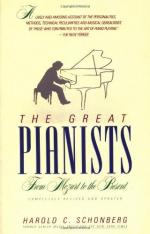
|
| Name: _________________________ | Period: ___________________ |
This test consists of 5 multiple choice questions, 5 short answer questions, and 10 short essay questions.
Multiple Choice Questions
1. How old was Paderewski when he debuted in 1887?
(a) 24.
(b) 30.
(c) 19.
(d) 16.
2. When was Ignacy Jan Paderewski born?
(a) 1860.
(b) 1900.
(c) 1872.
(d) 1798.
3. Who was considered Liszt's equal and a "living impersonation of Chopin"?
(a) Carl Tausig.
(b) Louis Moreau Gottschalk.
(c) Franz Liszt.
(d) Hans von Bulow.
4. What German pianist, composer, piano teacher, and piano manufacturer was born in 1785?
(a) Adolf von Henselt.
(b) Bartolomeo Cristofori.
(c) Friedrich Kalkbrenner.
(d) Johann Nepomuk Hummel.
5. What term is used to identify a type of music that is a singing, nuanced, fluffy, polite, and melodic approach developed after Bach's death when the heavy contrapuntal style used in the tempestuous fugue fell into disfavor?
(a) Fugue.
(b) Sonata.
(c) Legato.
(d) Etude.
Short Answer Questions
1. Chopin's music was critiqued as exotic or even insane for its "bold dissonance and strange _____."
2. What great pianist played piano as he sat erect and formal with minimal movement and earned the nickname Old Arpeggio?
3. What was an ill-defined method of balanced playing where stronger emphasized notes were offset by lesser emphasized notes?
4. What German pianist and composer was a pupil of Hummel and Sechter and became court pianist in St Petersburg?
5. In what year did Johannes Sebastian Bach die?
Short Essay Questions
1. When and where did piano playing arise in history? What instruments led up to the development of the piano?
2. Who was Saint-Saens? What were his musical contributions?
3. Who held the first solo concerts of the romantic period? What were they like?
4. Describe the early life and career of Mozart. How old was he when he first performed musically?
5. How are Franz Liszt's fans described in Chapter X, Thunder, Lightning, Mesmerism, Sex? How did Liszt react to the public?
6. How does the author describe Mozart's playing style in Chapter II, It Should Flow Like Oil?
7. What formal training did Ignacy Jan Paderewski receive and where?
8. Where did Hummel's piano training take place? How is he described as a performer?
9. How does the author describe changes in playing techniques in Chapter VI, In the Interim? Who initiated these adaptations?
10. How did musical styles evolve after the death of Bach? What is the definition of "contrapuntal style"?
|
This section contains 862 words (approx. 3 pages at 300 words per page) |

|




